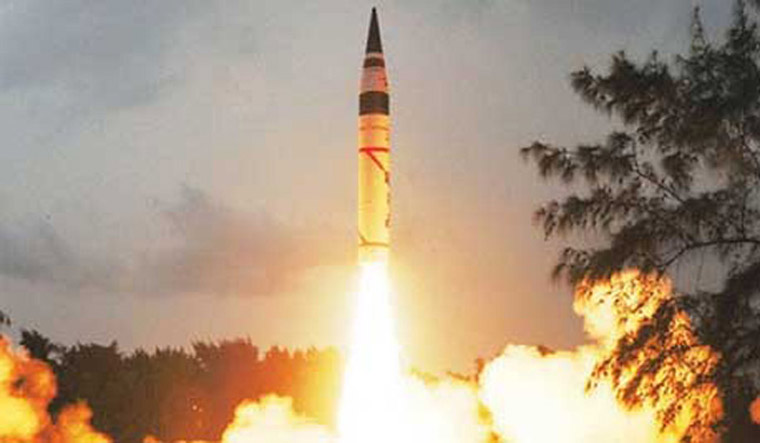
Bhubaneswar / New Delhi: : India on March 11 successfully test-fired its longest range ballistic missile Agni-V with multiple independently targetable re-entry vehicle (MIRV) technology from a defence facility off the Odisha coast. The test validated the weapon’s capability to destroy multiple targets at one go. Developed by the Defence Research and Development Organisation (DRDO), this was the first test of the intercontinental range ballistic missile (ICBM) Agni-V with MIRV technology.
“Proud of our DRDO scientists for Mission Divyastra, the first flight test of indigenously developed Agni-5 missile with Multiple Independently Targetable Re-entry Vehicle (MIRV) technology,” Prime Minister Narendra Modi posted on social media handle X. The successful launch of Mission Divyastra is a significant step towards India’s strategic punitive capability.
Launched from the complex IV located at Abdul Kalam Island of the Integrated Test Range (ITR) in full operational configuration, the test-firing of the most advanced nuclear capable missile system was the first flight test of indigenously developed 6,000 km range nuclear missile Agni-5 missile with Multiple Independently Targetable Re-entry Vehicle (MIRV) technology. Now, a single missile by India can deploy multiple war heads at different locations or at the same location with a time gap. These warheads could also include decoys to hoodwink the enemy’s ballistic missile defence programme.
According to defence sources, the missile with a strike range of over 5000 km was fired in a reduced trajectory intended for the Mission Divyastra to validate the state-of-art technology. The missile blasted off from the confines of its canister, a hermetically-sealed airtight container mounted on a Tatra truck launching platform. “The missile manoeuvred using on-board rocket motors and computerised inertial guidance system after the boost phase. It took up a ballistic trajectory before delivering a re-entry vehicle containing dummy warheads and then released a warhead at a pre-coordinated location. The vehicle then manoeuvred to a different trajectory releasing another warhead,” reported a media outlet quoting a source.
Usually the missiles are launched with single-warheads against one target. Under development since the first test of Agni 5 in 2012, the MIRV technology was originally planned for Agni 6 series of missiles. It is learnt that the MIRV technology was finalised with the Agni Prime missile and then after the tests, the decision was taken to go for Agni 5 as well. The MIRVed missiles can dispense warheads and neutralise multiple targets. With MIRV technology, Agni-V can deliver 10 to 12 warheads at different trajectories depending on the requirements. The missile is capable of hitting targets in all Asian countries and parts of Africa and Europe. Once the MIRV technology is mastered, it will equip 2000 km range Agni Prime and 4000 km range Agni-IV besides the Agni-V and Agni-VI missile, which is under development.
India with the test of Mission Divyastra has joined the select group of nations – the US, UK, France, Russia and China – that have deployed MIRV missile systems. The MIRVs were developed in the early 1960s and all major countries including China boast of it. For the first time India has publicly acknowledged to have successfully developed the technology. Pakistan is also pursuing its own MIRV capability and had in October last year carried out its second test launch of the Ababeel medium-range ballistic missile that has been designed to carry MIRVs. But for India to pull it off on the Agni 5 inter-continental ballistic missile is an advantage.
With the test, India has also managed to ace the technology for miniaturised nuclear warheads. According to sources, the system is equipped with indigenous avionics systems and high accuracy sensor packages, which ensured that the re-entry vehicles reached the target points within the desired accuracy. This capability is a statement of India’s growing technological prowess, they said and also pointed out that the project director was a woman.
A complex technology, the MIRV needs a very delicate combination of large missiles, small warheads, accurate guidance, and a complex mechanism for releasing warheads sequentially during flight. At present, some countries are reported to have the capabilities to have a single missile carry up to 16 warheads, each in a separate re-entry vehicle. Warheads on MIRVed missiles can be released at different speeds and in different directions, with such missiles capable of hitting targets as far as 1,500 km apart. The US was the first country to develop MIRV technology, deploying a MIRVed Intercontinental Ballistic Missile (ICBM) in 1970 and a MIRVed Submarine-Launched Ballistic Missile (SLBM) in 1971. The Soviet Union caught up quickly and developed their own MIRV-enabled ICBM and SLBM technology by the end of the 1970s.
Defence Minister Rajnath Singh and Union Home Minister Amit Shah congratulated DRDO scientists and the armed forces for the achievement. Attracting global attention, Mission Divyastra saw Chinese spy ships Xiang Yang Hong 03 and Xiang Yang Hong 01 getting positioned in the Indian Ocean and Bay of Bengal regions respectively prior to the test to monitor the performance of MIRVed Agni-V.















